By John Borthwick
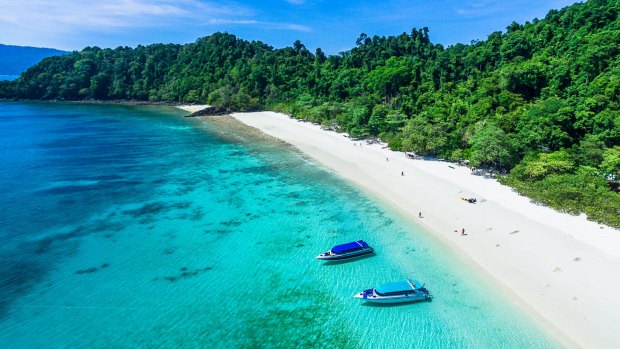
The jungle-clad islands of the Mergui Archipelago lie in a 400-km long, north-south scattering down Myanmar's coast.Credit: Shutterstock
"Parts of this archipelago are still so unmapped that at times we've been anchored straight off a beautiful beach and the island isn't even on the chart," says the yacht's chef Stefan Lange.
We've crossed to the southern Myanmar port of Kawthaung (formerly Victoria Point) from Ranong in Thailand to join our ketch, Meta IV. As we set sail for the much forgotten Mergui (pronounced mer-gwey) Islands of the Andaman Sea, he adds: "Turn your watches back half an hour and 200 years."
The jungle-clad islands of the Mergui Archipelago lie in a 400-km long, north-south scattering down Myanmar's coast. In the myths of the nomadic Moken seafarers, who have lived here for up to 4000 years, the islands broke off from the mainland following a great mythological flood. Our six-day ramble will take us through the southern clusters of these 800 mostly uninhabited, limestone and granite islands.
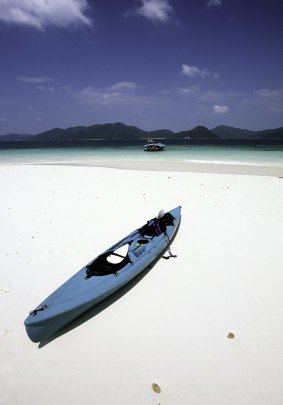
Myanmar: Experience untrodden beaches.Credit: John Seaton Callahan
Meta IV, a 25-metre, white-hulled thing of teak and grace, heads west into the sunset. We anchor for the night off a nameless, wooded shore. While the chef conjures dinner of steamed crab and herbs in the galley, and the three-man Thai and Burmese crew – Captain Suchet, guide Aung Kyaw Kyaw (A.K.) and deckhand Won – plot tomorrow's course, we seven passengers need to do little but get acquainted over drinks on the aft deck.
Night falls. Local squid boats, a blaze with lure lights, float on the horizon like the phantom green fairies of an absinthe drinker's dream. Later, almost too well-fed, I lie on the roof of the cabin, staring up at the infinite stars snagged in the rigging until I drift to sleep.
Come morning, we plunge overboard – the best way in the world to wake up. I take a kayak and paddle ashore across emerald shallows that skirt a mangrove forest. A brahminy kite scoots low. Onshore, unseen in the hills are hornbills, macaque, gibbon and mouse deer. This is not yet an Eden in retreat.
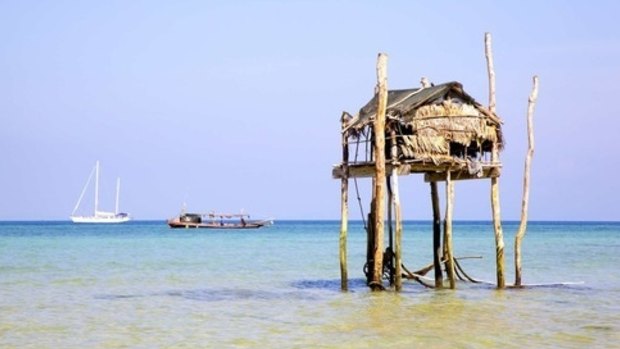
Moken hut and tour boat, Mergui Islands, Myanmar.Credit: Burma Boating
The Mergui (sometimes known as Myeik) Islands, weren't always so overlooked. Centuries ago the mainland port of Mergui was an important trading stop for European ships and for travellers crossing the Malay Peninsula to reach Siam's early capital, Ayutthaya.
When Burma (as Myanmar was then known) was ruled by British India, many islands were given earnest, whiskery names such as Great Swinton and Lord Loughborough that honoured or flattered the captains of empire. A few islands received more lively titles such as Cockscomb, Rhino and Alladin but later nationalists overwrote most with local names, although clearly running out of inspiration at times with bald tags such as "Island No.115".
Our impeccable ketch is registered, anomalously, in Salzburg, Austria, a sea-less "port" more famed for Mozart and snow than tropical tides and sun. The boat's distant home reflects the background of the Asia-based, Austrian and German yachting friends who founded Burma Boating several years ago, initially with just Meta IV. (The name refers to the Buddhist concept of "meta", loving kindness.) Their fleet of quality vessels has grown to nine, including a converted exploration boat and catamaran.
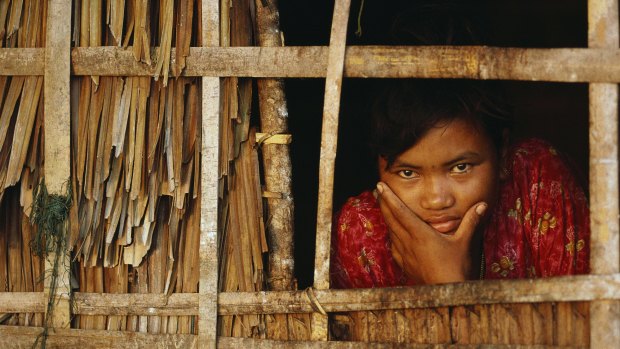
A Moken woman looks out from inside her home, Myanmar.Credit: Nicolas Reynard
Life on board is easy as we meander among islands that range in size from tiny to hundreds of square kilometres. We're sailing post-monsoon and the winds are light so we motor more often than proceed purely under sail. My fellow passengers are an Australian-Singaporean pair enjoying their postponed honeymoon, and two couples from the UK.
Our teak-lined cabins are neat, nautical and have opening skylights, air-conditioning and ensuite toilet-showers. What we don't have is Wi-Fi, mobile signal and the other allegedly vital signs of 21st century life. Instead, we snorkel (although, sadly, at times over coral that has been decimated by dynamite fishing) and go ashore daily to beaches untrodden except for the occasional footprints of a jungle cat.
Several times we come alongside local longtail fishing boats, cluttered with nets, lines and squid lights, while the crews barter cans of soft drink and beer for a handsome catch of seafood. Fresh sashimi tonight. Crayfish tomorrow. In six days I see just three non-Burmese boats, two of them being our sister ships and the other a chartered dive boat.
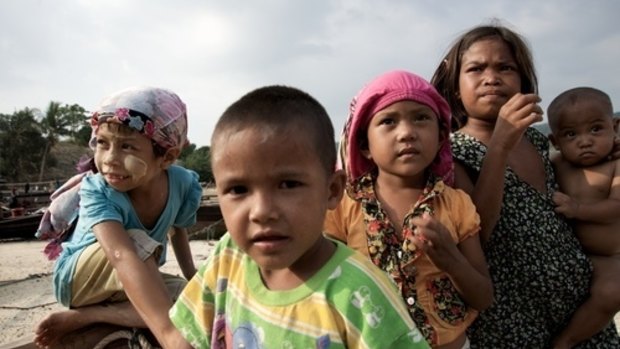
Moken kids, Mergui Islands, Myanmar.Credit: Burma Boating
These continental islands were off limits to foreigners until 1997 when the first dive operators negotiated limited access. They had enjoyed scant international mention for much of the preceding century, bar in a few W.E. Johns's Biggles air adventure books and the 1965 James Bond movie Thunderball, in which the evil Ernst Stavro Blofeld demands a vast ransom in diamonds, to be paid here in the archipelago.
"Is this how Phuket would have looked 40 years ago?" asks one of our English travellers, gazing out on a virgin shore. More like 240 years ago, I imagine. Today, around 2000 tourists visit annually, by boat alone, between October and May, with sea conditions being unfavourable during the months of the south-west monsoon.
The Mergui region came dramatically, if briefly, to Australian attention in November 1935 when air pioneer Sir Charles Kingsford Smith and his co-pilot Tommy Pethybridge perished in the area while attempting the England-to-Australia speed record. An intensive RAF search failed to find them. Landing gear from their plane Lady Southern Cross was retrieved later, indicating they had probably crashed in the sea well north of the archipelago. Our Burmese guide A.K. has been part of the team searching for the plane's engine block, so far without success and, he notes, any help from the Australian government.
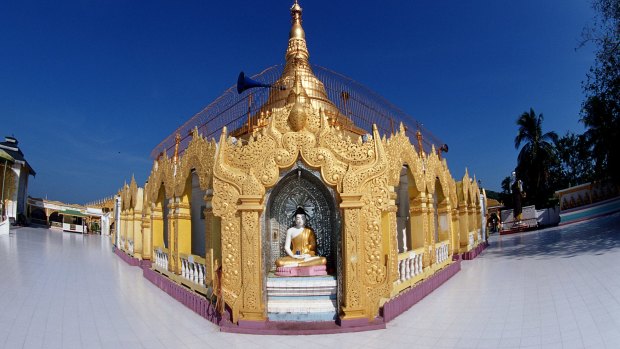
Temple, Kawthaung, Myanmar.Credit: Reinhard Dirscherl
We pull into a broad sheltered bay backed by jungle on Jarr Lan (formerly Lord Loughborough) Island. A score of Moken children come charging out to greet us in dugout canoes, rowing in a standing position with crossed oars. The Moken, an Austronesian ethnic group who have inhabited the Andaman coasts for millennia, traditionally spent half the year at sea aboard their 10-metre kabang boats. While known romantically in English as "sea gypsies", a more accurate term might be sea nomads, although their traditional migrations are now much disrupted.
Around 3000 Moken live among the Mergui Islands with this village, Jalan, one of the largest. The children, who look healthy and well fed, follow us ashore in our inflatable boat like an excitable, nautical Pied Piper tribe and later clutch our hands as we wander through their home. It's a 100-metre long row of ramshackle wooden stilt houses perched above the water, with another row set slightly back on terra firma. Tin roofs, plastic and a few satellite dishes signal that the mainland is only 50 kilometres east of here.
We watch older women in sarongs boil their catch of trepang, or sea cucumber, while others dry fish or make charcoal. Three women, their faces daubed with white thanaka paste, heave the stones they have gathered out of a canoe, building a small pier. I see few young men, most of them away on fishing boats or on the mainland. At one end of town we visit the schoolhouse and a Buddhist temple, government efforts to both educate and draw the animist Moken into a sense of national, Buddhist-Myanmarese identity.
"We Moken are born, live and die on our boats. The umbilical cords of our children plunge to the sea," says one of the lengthy epics in their considerable oral literature. They can free dive deeper and longer than probably any other indigenous people. Their children swim before they can walk. They seem to have no words for "worry", "want" or "goodbye". And yet the governments of Myanmar and Thailand (where they also live) would rather have them "come ashore", often to dispirited communities where alcohol, boredom and gambling achieve their familiar outcomes.
British photographer Cat Vinton, who spent several weeks aboard a kabang documenting a Moken family, writes: "Over the past few years it has became more difficult for the dwindling numbers of nomadic Moken still clinging to their wandering way of life. Mass fishing and aggressive assimilation policies have firmly pointed them towards land."
We sail on, through what has been called a "lost island world" and a "maritime Shangri-La". Sundowners and sublime silences. Fresh pan-fried squid with squid-ink pasta. Evergreen ridges of mahogany and teak. Swim ashore in the morning across mirror waters.
The Moken beat us all to the Merguis by some 200 generations. And yet, when you paddle alone round a rocky point or along a mangrove shore to find no sign at all of human imposition, you know what Coleridge's mariner felt when he mused, "We were the first that ever burst into that silent sea."
John Borthwick was a guest of Burma Boating and Tourism Authority of Thailand.
TRIP NOTES
MORE INFORMATION
Myanmar issues tourist visas on arrival but always check beforehand. All foreign visitors pay an official "Mergui fee" equivalent to $350; the cruise company collects this during booking.
GETTING THERE
A cruise is the only way to visit the Mergui Islands. Most depart from Kawthuang, Myanmar, across the river border from Ranong, Thailand. Fly to Ranong from Bangkok with Nok Air (see www.nokair.com) or drive north from Phuket. Alternatively, fly to Kawthaung from Yangon.
WHEN TO GO
October to May.
STAYING THERE
In Ranong, the Numsai Khaosuay Resort, see numsaikhaosuay.com; in Kawthaung, Victoria Cliff Hotel, see www.victoriacliff.com.
SAILING THERE
Burma Boating has nine vessels. A five-night cruise on the flagship SY Meta IV costs around $3085 per person, twin share, see www.burmaboating.com
FIVE THINGS TO DO
Visit Kawthaung (pronounced "Cow Thong"), Myanmar's southernmost town, is a busy fishing port. Depending on your inclination, there's a Buddhist temple on the hill or Andaman Club casino island.
Visit a Moken "sea nomad" village on Nyaung Wee or Jar Lann islands.
Dive. There is some excellent diving in this region, including encounters with whale sharks and rays. Look for a boat that is dive-equipped.
Kayak, snorkel, fish and swim.
Experience Ranong, one of Thailand's most unspoiled regional capitals. It is clean, quiet and "un-touristed", and has excellent hot springs.
See also: 18 incredible islands that offer much more than sun and sand
See also: 10 remote islands to add to your bucket list
Sign up for the Traveller Deals newsletter
Get exclusive travel deals delivered straight to your inbox. Sign up now.